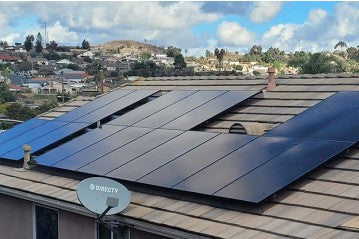
As the world continues to embrace sustainable energy sources, solar power has emerged as a reliable and eco-friendly solution. Solar energy harnesses the power of the sun to generate electricity, providing an alternative to traditional fossil fuels. If you're considering investing in solar energy products, it's essential to understand the three main types of solar power systems: on-grid, off-grid, and hybrid-grid. In this blog post, we will explore each solar power system's characteristics, benefits, and main components to help you make an informed decision.
1. The Three Main Types of Solar Power Systems
1.1 On-Grid Systems

On-grid solar power systems, also known as grid-tied or grid-connected systems, are the most common type. These systems are connected to the local utility grid, allowing for a seamless integration of solar-generated electricity and traditional grid power. Here's how it works:
- Solar panels installed on your property convert sunlight into DC (direct current) electricity.
- The DC electricity is then sent to an inverter, which converts it into AC (alternating current) electricity, compatible with your home's electrical system.
- The AC electricity powers your appliances, with any excess electricity fed back into the utility grid.
- When your solar panels don't generate enough electricity, such as during nighttime or cloudy days, you can draw power from the grid.
On-grid systems offer several advantages, including:
- Lower upfront costs due to the absence of battery storage.
- The ability to benefit from net metering, where excess electricity fed into the grid earns credits that can be used to offset future utility bills.
- Minimal maintenance requirements since the grid acts as a backup power source.
1.2 Off-Grid Systems

Off-grid solar power systems, also known as standalone systems, are independent of the utility grid. These systems are suitable for remote locations or areas with unreliable or no access to grid electricity. Here's how they operate:
- Solar panels convert sunlight into DC electricity.
- The DC electricity is stored in a battery bank, which allows for power supply during times when the sun isn't shining.
- An inverter converts the stored DC electricity into AC electricity, providing power for your home or business.
Off-grid systems provide the following benefits:
- Energy independence, enabling you to generate and use electricity without relying on the grid.
- Reliability in areas prone to power outages or with limited grid infrastructure.
- Environmental sustainability by reducing reliance on fossil fuels.
1.3 Hybrid-Grid Systems

Hybrid-grid solar power systems combine the advantages of both on-grid and off-grid systems. These systems are connected to the utility grid but also have battery storage for backup power during grid outages or when solar generation is insufficient. Here's how they function:
- Solar panels convert sunlight into DC electricity.
- The DC electricity is sent to an inverter, which converts it into AC electricity to power your home and charge the battery bank.
- Excess electricity is directed to the grid, earning you credits through net metering.
- During power outages or when solar generation is inadequate, the battery bank supplies electricity to your home, ensuring uninterrupted power supply.
Hybrid-grid systems offer the following advantages:
- Energy independence during grid outages or disruptions.
- The ability to store excess solar energy for later use, reducing reliance on the grid during peak demand times.
- Enhanced flexibility and control over your energy usage.
2. Main Components of a Solar System
Regardless of the solar power system type, several key components are integral to their functioning:
2.1 Solar Panels: Photovoltaic (PV) panels comprised of multiple solar cells that convert sunlight into electricity.
2.2 Inverter: Converts the DC electricity generated by the solar panels into AC electricity, suitable for powering your home or business.
2.3 Battery Bank (for off-grid and hybrid systems): Stores excess solar-generated electricity for use during periods of low or no solar generation.
2.4 Charge Controller (for off-grid and hybrid systems): Regulates the flow of electricity between the solar panels and the battery bank, preventing overcharging or discharging.
2.5 Metering System: Measures the amount of electricity generated and consumed, facilitating net metering and monitoring energy usage.
2.6 Mounting System: Securely holds the solar panels in place, typically installed on rooftops or ground-mounted frames.
Conclusion
Understanding the different types of solar power systems and their components is crucial when considering a solar energy investment. On-grid systems provide affordability and convenience, while off-grid systems offer independence and reliability. Hybrid-grid systems combine the benefits of both, ensuring uninterrupted power supply and flexibility. By considering your specific energy needs, geographical location, and budget, you can make an informed decision that aligns with your sustainability goals. Embrace the power of solar energy and pave the way for a greener future.

0 comments